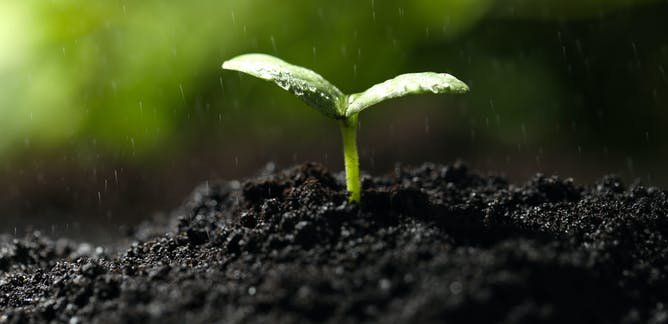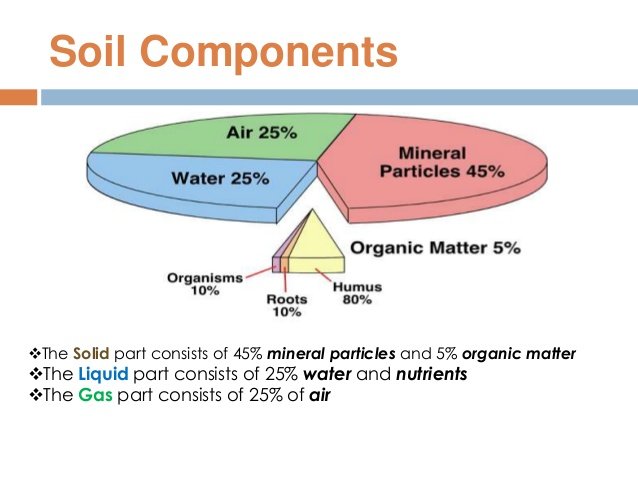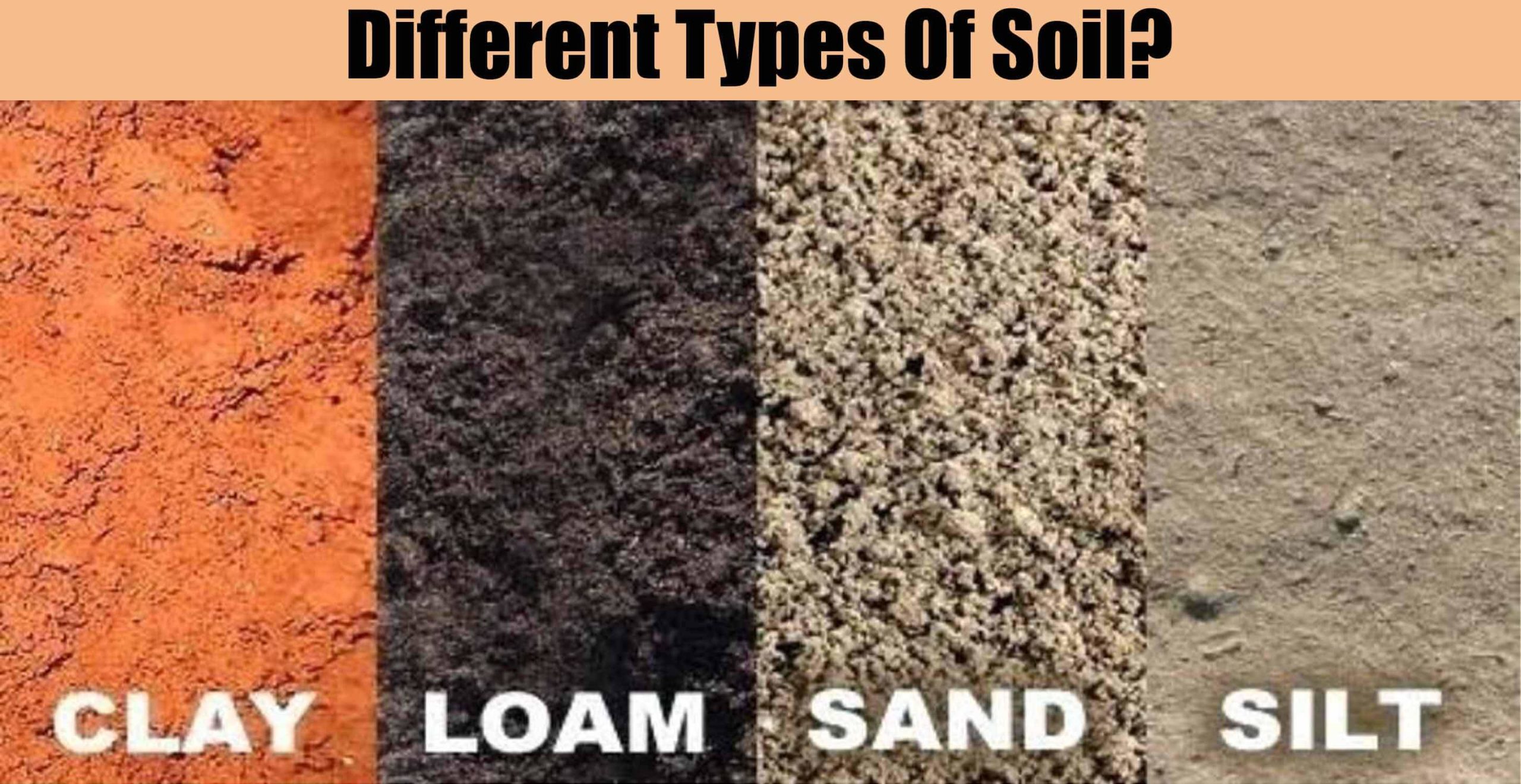Back to: GEOGRAPHY SS2
Welcome to class!
In today’s class, we will be talking about environmental conservation. Enjoy the class!
Environmental Conservation

Environmental conservation is the process of preserving natural resources from loss, waste or exploitation to ensure continuous availability.
Environmental conservation methods include the following:
- Afforestation
- Re-afforestation
- Cover-cropping
- Improved farming techniques
- Environmental education
- Recycling
- Legislation against environmental degradation.
EVALUATION
- Define environmental conservation.
- Mention some of the methods of environmental conservation.

SOIL
Soil is defined as the thin surface of the uppermost layer of the earth crust on which plants grow.
Composition or Components of Soil
Soil is made up of five components which are (i) inorganic or mineral matter (ii) organic matter (iii) soil water (iv) soil air (v) living organisms
Mineral or Inorganic matter, organic matter, water and air are collectively referred to as physical components of the soil while living organisms are referred to as biological components of the soil.
Mineral or Inorganic Matter:
The mineral matter represents small rock fragments of the soil. It forms the bulk of about 45% of the total volume of the soil. It consists of gravel, stones, sand, silt and clay.
Importance/Effects of Mineral Matter on Agriculture
- It forms the solid part of the soil which provides support for plants.
- Mineral matter is the main source of plant nutrients such as nitrogen, calcium, magnesium iron etc.
- It represents the home or habitat of all soil living organisms.
- It holds water and air for both plants and animal activities.
- The mineral matter has moderating effects on soil temperature.
- It also affects soil porosity.
Organic Matter:
The organic matter represents the remains of the decomposition of plants and animals. It is about 5% of the total volume of the soil. Leaves, roots of plants, the residue of crops, animal dung, etc. when they are deposited on the soil, they decay to form a dark colour on the upper part of the soil. This becomes organic matter which is also called humus.
Importance / Effects of Organic Matter on Agriculture
- It is very rich in plant nutrient.
- It is the habitat of many soil micro-organisms.
- It prevents leaching in the soil where it is present in adequate amount.
- It also prevents soil erosion and evaporation of soil water.
- It allows for good drainage and holds water in the soil for plant use.
- It improves the structure of the soil by binding particles together.
- It increases the water-holding capacity of the soil.
- It moderates the soil temperature.
- It has a moderating effect on the PH value.
Soil Water:
Soil water refers to the water in the soil which is usually obtained either from rain or irrigation. Water represents 25% of the total volume of the soil. It is usually found in the pore spaces of the soil. When water is too much in a soil (covering the soil surface), the soil is said to be Waterlogged. Waterlogged soil can, however, be improved by drainage to make such soil more productive. On the other hand, when there is complete lack of water in the soil for a very long time such that plants cannot absorb water even when supplied again, this results in a condition called permanent wilting point. The plant at this stage can die.
Importance / Effects of Soil Water in Agriculture
- Water is an important agent of weathering of rocks in the soil.
- It helps to dissolve plant nutrients into solution form.
- Water is an essential raw material for photosynthesis.
- Hydrolysis of many food nutrients and enzymatic activities.
- Loss of water from plant through transpiration helps in the cooling of the plant.
- Presence of water aids easy tillage of the soil and also improves the soil structure.
- It also promotes the activities of soil organisms.
- It is needed for the germination of seeds.
Soil Air:
This refers to the gases present in the soil pore spaces found between the soil particles. The amount of soil air varies, depending on the amount of soil water, the size of the pore spaces, the type of soil and the amount of living organisms in the soil. The percentage of air is about 25% of the total volume of the soil. The ability of air to circulate freely in the soil is called aeration.
Importance / Effects of Soil Air on Agriculture
- Oxygen is necessary for the growth and development of plants.
- Oxygen in the soil promotes easy germination of seed.
- Soil organisms require oxygen for respiration.
- Excess of carbon dioxide in the soil, when combined with water can cause acidity and aid weathering of rocks.
- Air is needed in soil reaction particularly carbon and nitrogen cycles.
Living Organisms:
This refers to plants and animals which inhabit the soil. They range from microscopic organisms to bigger organisms. Some are beneficial while others are harmful to crops and livestock. The most commonly found groups of soil organisms include bacteria, fungi, virus nematodes, insects e.g. termites, soldier ants, millipede, centipede, earthworm, snails, reptile, mammals, (e.g. rats and rodents).
Importance/Effects of Living Organisms on Agriculture
- They help to improve the aeration of the soil.
- They help to decompose organic materials in the soil to form humus.
- They aid the percolation of water.
- They improve the structure of the soil.
- Some organisms like bacteria help to fix nutrients into the soil.
- Some are pests and parasites while some cause diseases of crops.
- Some soil micro-organisms produce acidic materials which help to break down rocks.

EVALUATION
- Mention the components of soil.
- Outline four importance of the organic matter to the soil.
Types of Soil and their Properties
There are three main types of soil. These are: (i) sandy soil (ii) clay soil (iii) loamy soil
Sandy Soil:
- A soil is said to be sandy if the proportion of sand particles in a sample of soil is very high.
- The particles are mainly quartz (SiO2).
- They have the size of 2.0mm in diameter.
- Sandy soil is not very good for farming because it is poor in plant nutrients.
Properties of Sandy Soil
- Sandy soil is coarse, grainy and gritty.
- It is loose with large pore spaces.
- It is well aerated and cannot hold water.
- Percolation is high but capillarity is low.
- It is not sticky when wet.
Clay Soil:
- A soil is said to be clayey if the proportion of clay in a sample of soil is very high.
- The relative size is less than 0.002mm in diameter.
- It is a heavy soil because it is very difficult to work on or cultivate.
Properties of Clay Soils
- Clay soil is fine-grained and smooth.
- Particles are tightly packed with little pore spaces.
- It is poorly aerated and can hold water.
- Percolation is low but capillarity is high.
- It is sticky when wet and hard when dry.
Loamy Soil:
- Loamy soil is a mixture of sand, clay with a high proportion of organic matter.
- Loamy soil is the most fertile and the best soil for farming.
Properties of Loamy Soil
- Loamy soil is moist and loose.
- It contains lots of organic matter (humus).
- It does not support erosion and waterlogging.
- It is well aerated and can hold water.
Characteristics of Soil
Certain features or characteristics are used to identify or describe a soil sample. These are:
- Soil colour
- Soil texture
- Soil structure
- Permeability
- Porosity
- Soil PH
EVALUATION
- Describe a sandy soil.
- State the properties of loamy soil.
- Define soil.
- Mention three types of soil.
- Mention two characteristics of each of this soil type.
PROCESSES OF SOIL FORMATION
The following are the processes of soil formation:
- Weathering of parent materials.
- The action of Chemicals.
- Further Disintegration.
- The appearance of biological activities.
- Formation of humus.
- Final soil formation.
SOIL PROFILE
A soil profile is defined as the vertical section through the soil to the underlying rocks, showing a series of horizontal layers. These horizontal layers are called horizons.
A typical soil profile has three layers or horizons which are A, B and C horizons.
A- HORIZON:
A horizon is also called topsoil.
- It represents the surface layer of the soil profile.
- It contains more humus or organic matter.
- It is the zone of eluviation where minerals are leached down the profile.
- It has maximum biological activities of plant and soil micro-organisms.
B – HORIZON:
B horizon is also called subsoil.
- It is the zone of illuviation where soil minerals accumulate, especially those leached from the A-horizon.
- It contains a lot of mineral matter.
- There is the conversion of organic matter from A – horizon into inorganic matter.
- This zone contains leached materials.
C- HORIZON:
C horizon is also called the zone of parent materials.
- It contains weathered parent rocks.
- It represents materials from which top and sub-soil are formed.
- Beneath the C Horizon is the bedrock.

Importance of Soil Profile
- It determines the level of fertility of the soil e.g. thick topsoil represents a high level of soil fertility.
- It helps the farmer to know the type of crop to grow.
- It determines the level of root penetration, drainage and aeration.
- It determines the rate of percolation of water and the level or degree of soil erosion.
Importance of Soil
- Agriculture: It provides the only medium through which agriculture is practised to provide food for man.
- Building: All buildings are sited and erected on soils.
- Construction: Various forms of construction like roads, railway, industries etc. are constructed on the soil.
- Vegetation: All vegetation types form their basis on the soil. Without soil, plants cannot get support and nutrient for growth.
- Storage of nutrient: Soil provides plants and crop with all nutrients for their continuous existence.
- Habitat of organisms: Soil provides the habitat for most organisms, especially bacteria, earthworms, termites and rodents.
- Reservoir for water and air: Soil also acts as a reservoir for air and water needed by a living organism to survive.
- Provision of minerals: the soil is the source of all minerals used by man.
GENERAL EVALUATION
- What is soil?
- State factors affecting soil formation.
- Mention five processes of soil formation.
- Differentiate between rotation and revolution.
In our next class, we will be talking about Transportation in Nigeria. We hope you enjoyed the class.
Should you have any further question, feel free to ask in the comment section below and trust us to respond as soon as possible.


it help alot for students
it make our work easier and faster